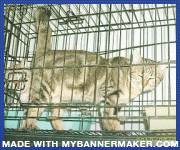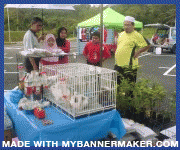Rabbits are the most prolific small-farm animals
 Breeding rabbits is not difficult at all, and is a great way to ensure your family has a steady supply of meat. By six months old, rabbits are considered mature. Once a doe is ready to be bred place her in the buck’s cage (never bring the buck to the doe’s cage). It doesn’t take very long, but if the doe resists then remove her after a few minutes and try again the following day. If she continues to resist one particular buck put her in with a different buck. Once the deed in done remove the doe and return her to her own cage. Bucks have been known to get edgy after mating and start biting the doe, so don’t leave them together once mating has been accomplished. To ensure the beeding “takes”, place the doe back with the buck for a second time about 12 hours after the first time. Also, don’t be alarmed if the buck shows his joy after mating by falling over and shrieking, it’s perfectly normal...and comical! |
A Nest Box is Important

Gestation is about one month. After 10 days check the doe by flipping her on her back (holding her like a baby) and feel for the babies which are about marble-sized at this point. A few days before the babies are due put the nest box in the cage. Make sure it contains some clean, dry hay. Soon before giving birth (usually at night) the doe will rearrange the hay and pull her belly fur to build a nest.
A litter is usually consists of 6 to 10 babies. After the birth, open the nest box and check the babies and remove any that are dead; keep your scent off the babies by wearing gloves. Give the mother a bit of apple to keep her occupied while inspecting her babies.
It’s important that you keep the nest box clean and after a few weeks you can remove it. The doe can be rebred once the current litter reaches four to five weeks old.

Once they are weaned (6 to 8 weeks) then you must decide whether to butcher them, keep feeding them to fatten them up, keep some for breeding stock or to sell. Just remember the longer you feed them the more it is going to cost you. By butchering immediately after weaning all feeding will be done by the doe.
An additional note, don’t remove all the bunnies at the same time. Remove them gradually to allow the doe’s milk to dry up slowly. Also, while the bunnies are still small they can be kept together in one cage, but eventually after a couple of months they will each need their own cage.
Another part of breeding rabbits is to keep track of which bucks and does have produced which offspring to avoid any chance of inbreeding. Experienced breeders start with two does and two bucks, breeding the progeny of buck one by buck two and visa versa.















No comments:
Post a Comment